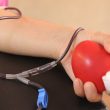Courtesy of Dr. Alejandro Lakowsky, MTSAC. The Journal of the American College of Cardiology (JACC) has recently published a study on the role of coronary anatomy and PCI technical difficulty in the cost benefit ratio of prolonged vs. short post procedural DAPT. This study was carried out by Robert Yeh, Laura Mauri and the DAPT trial...
Protective Shield RADPAD Reduces the Radiation Dose Received by Operators in the Cath Lab
Despite technological developments, all people working at a cath lab are inevitably exposed to radiation and its effects. The radiation dose received by the operator is highly variable depending on procedure type, experience level, equipment used, patient characteristics, etc. Exposure to this scatter radiation may have deterministic effects, such as the onset of cataracts or...
Angioplasty Complexity May Define the Duration of Dual Antiplatelet Therapy
The DAPT study concluded that continued thienopyridine plus aspirin beyond a year after coronary angioplasty is associated with a decrease in the rate of stent thrombosis and major cardiovascular events. In contrast, there is a significant increase in moderate to severe bleeding when compared with continued aspirin alone. Based on the outcomes of this and...
Though on the Rise, the Transradial Approach to Primary PCI Remains Underused
There is evidence to support the use of the transradial approach to coronary angioplasty. Several randomized studies have shown reduced bleeding and vascular complications when adopted, compared against patients treated with the femoral approach. There are also studies and meta-analysis suggesting that, in the context of primary PCI, the benefit would be even bigger, with significant events...
The End of Aspirin for Anticoagulated Patients Undergoing PCI
The discussion about the best anti-thrombotic strategy for patients with atrial fibrillation undergoing PCI seemed never-ending until the RE-DUAL PCI trial was published in the New England Journal of Medicine (NEJM). This study has arrived to simplify the tough choice between the risk of a thrombotic event vs. the risk of bleeding with a simpler scheme, without...
TCT 2017 | FAME 2 at 3 Years: Better Results with Angioplasty and at a Cost Similar to Medical Treatment
Courtesy of SBHCI. Angioplasty in patients with chronic stable angina and functionally significant lesions improves clinical outcomes and quality of life over the long term, as compared with optimal medical therapy alone. Furthermore, the invasive approach becomes more cost-effective as the years go by. Previously, FAME 2 had shown that angioplasty was initially more expensive, but...
TCT 2017 | ORBITA: The Placebo Effect of Angioplasty
Courtesy of the SBHCI. Chronic stable angina and severe coronary lesion patients who undergo angioplasty in a single vessel show no better outcomes than individuals who undergo a placebo sham procedure when it comes to exercise capacity and symptoms, according to this study presented at TCT and published simultaneously in the Lancet. The curious results...
EXCEL-QOL Substudy: Similar Quality of Life both with CABG and Left Main PCI
Courtesy of SBHCI. According to a new quality of life sub-study, the “EXCEL”, both coronary artery bypass graft and left main PCI are associated with significant clinical improvement in terms of angina frequency, tolerance to exertion and treatment satisfaction. At 12 and 36 months, there were no significant differences between PCI and surgery after several quality of...
2.0-mm DES for Very Small Vessels: Are They Viable?
The reference vessel diameter is a fundamental factor for restenosis after coronary angioplasty even with drug-eluting stents. The smallest sized stents available are 2.25 mm in diameter, but even smaller vessels can be symptomatic. This was a prospective multicenter trial of the Resolute Onyx 2.0-mm zotarolimus-eluting stent. The primary endpoint was target lesion failure. Read also: “Effects...
Impella Improves Safety in High Risk Unprotected Left Main PCI
Courtesy of Dr. Carlos Fava. The incidence of unprotected left main severe stenosis ranges between 4 and 8%, and it’s mostly associated with multivessel disease. The use of left ventricular support devices in high risk unprotected left main PCI is on the rise, but not much information available in this regard. Read also: “Prior assistance...









